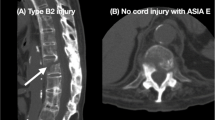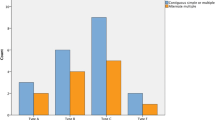Abstract
Purpose
Noncontiguous double-level unstable spinal injuries (NDUSI) are uncommon and have not been well described. In this study, we aimed to better understand the patterns of NDUSI, in order to recommend proper diagnostic and treatment methods, as well as to raise awareness among traumatologists about the possibility of these uncommon injuries.
Methods
A total of 710 consecutive patients with spine fractures were treated for >9 years since 2007 at a single regional trauma center. Of them, 18 patients with NDUSI were reviewed retrospectively.
Results
The incidence of NDUSI was 2.5 % of all spine fractures. In 17 of 18 patients (94.7 %), NDUSI was caused by a high-energy trauma. Nine patients (50.0 %) exhibited complete neurological deficit. Spinal cord injury occurred in the cranial injured region in all American Spinal Injury Association grade A cases. In one case, a second fracture was overlooked at the initial examination.
Conclusion
NDUSI are common in cases of high-energy trauma and should be taken into consideration at the initial examination. A second fracture may be easily overlooked because of the high frequency of concomitant severe spinal cord injury in the cranial injured region and/or loss of consciousness due to associated injuries. To avoid overlooking injuries, full spine computed tomography is useful at the initial examination. Operative reduction and internal fixation with instrumentation through a posterior approach is recommendable for cases of NDUSI. In elderly patients, a very rapid stabilizing surgery should be planned before aspiration pneumonia occurs or the pulmonary condition worsens.



Similar content being viewed by others
References
Griffith HB, Gleave JRW, Taylor RG (1966) Changing patterns of fracture in the dorsal and lumbar spine. Br Med J 1:891–894
Iencean SM (2002) Double noncontiguous cervical spinal injuries. Acta Neurochir (Wien) 144:695–701
Powell JN, Waddell JP, Tucker WS, Transfeldt EE (1989) Multiple-level noncontiguous spinal fractures. J Trauma 29:1146–1150
Cho SK, Lenke LG, Hanson D (2006) Traumatic noncontiguous double fracture-dislocation of the lumbosacral spine. Spine J 6:534–538
Calenoff L, Chessare JW, Rogers LF, Toerge J, Rosen JS (1978) Multiple level spinal injuries: importance of early recognition. AJR Am Roentqenol 130:665–669
Korres DS, Boscainos PJ, Papaqelopoulos PJ, Psycharis I, Goudelis G, Nikolopoulos K (2003) Multiple level noncontiguous fractures of the spine. Clin Orthop Relat Res 411:95–102
Vaccaro AR, An HS, Lin S, Sun S, Balderston RA, Cotler JM (1992) Noncontiguous injuries of the spine. J Spinal Disord 5:320–329
Gupta A, el Marsi WS (1989) Multiple spinal injuries: incidence, distribution and neurologic patterns. J Bone Joint Surg Br 71:692–695
Beldekos A, Korres DS, Nikolakakos GA (1981) Chance’s fracture in a double level fracture of the spine. Injury 13:34–36
Henderson RL, Reid DC, Saboe LA (1991) Multiple noncontiguous spine fractures. Spine 16:128–131
Hadden WA, Gillespie WJ (1985) Multiple level injuries of the cervical spine. Injury 16:628–633
Wittenberg RH, Hargus S, Steffen R, Muhr G, Bötel U (2002) Noncontiguous unstable spine fractures. Spine 27:254–257
Mahan ST, Mooney DP, Karlin LI, Hresko MT (2009) Multiple level injuries in pediatric spinal trauma. J Trauma 67:537–542
Mortazavi MM, Dogan S, Civelek E, Tubbs RS, Theodore N, Rekate HL, Sonntag VK (2011) Pediatric multilevel spine injuries: an institutional experience. Childs Nerv Syst 27:1095–1100
Carreon LY, Glassman SD, Campbell MJ (2004) Pediatric spine fractures: a review of 137 hospital admissions. J Spinal Disord Tech 17:477–482
Korres DS, Katsaros A, Pantazopoulos T, Haltofilakidis-Garofalidis G (1981) Double or multiple level fractures of the spine. Injury 13:147–152
Dai LY, Jia LS (1996) Multiple non-contiguous injuries of the spine. Injury 27:573–575
Tearse DS, Keene JS, Drummond DS (1987) Management of non-contiguous vertebral fractures. Pareplesia 25:100–105
Keenen TL, Antony J, Benson DR (1990) Non-contiguous spinal fractures. J Trauma 30:489–491
Pellise F, Bago J, Villanueva C (1992) Double-level spinal injury resulting in “en block” dislocation of the lumbar spine. A case report. Acta Orthop Belgica 58:349–352
Magerl F, Aebi M, Gertzbein SD, Harms J, Nazarian S (1994) A comprehensive classification of thoracic and lumbar injuries. Eur Spine J 3:184–201
Allen BL Jr, Ferguson RL, Lehmann TR, O’Brien RP (1982) A mechanistic classification of closed, indirect fractures and dislocations of the lower cervical spine. Spine (Phila Pa 1976) 7:1–27
Anderson LD, D’Alonzo RT (1974) Fractures of the odontoid process of the axis. J Bone Joint Surg Am 56:1663–1674
Levine AM, Edwards CC (1985) The management of traumatic spondylolisthesis of the axis. J Bone Joint Surg Am 67:217–226
Takami M, Yamada H, Nohda K, Yoshida M (2014) A minimally invasive surgery combining temporary percutaneous pedicle screw fixation without fusion and vertebroplasty with transpedicular intracorporeal hydroxyapatite blocks grafting for fresh thoracolumbar burst fractures: prospective study. Eur J Orthop Surg Traumatol 24(Suppl 1):159–165
Takami M, Nohda K, Sakanaka J, Nakamura M, Yoshida M (2014) Usefulness of full spine computed tomography in cases of high-energy trauma: a prospective study. Eur J Orthop Surg Traumatol 24(Suppl 1):167–171
Horn EM, Theodore N, Feiz-Erfan I, Lekovic GP, Dickman CA, Sonntag VK (2006) Complications of halo fixation in the elderly. J Neurosurg Spine 5:46–49
Daentzer D, Flörkemeier T (2009) Conservative treatment of upper cervical spine injuries with the halo vest: An appropriate option for all patients independent of their age? J Neurosurg Spine 10:543–550
Delcourt T, Bégué T, Sainttyves G, Mebtouche N, Cottin P (2015) Management of upper cervical spine fractures in elderly patients: current trends and outcomes. Injury 46:S24–S27
Acknowledgments
We declare that no organizations funded our research.
Author information
Authors and Affiliations
Corresponding author
Ethics declarations
Conflict of interest
All authors declare that they have no conflict of interest.
Ethical approval
All procedures performed in studies involving human participants were in accordance with the ethical standards of the institutional and/or national research committee and with the 1964 Helsinki Declaration and its later amendments or comparable ethical standards. This article does not contain any studies with animals performed by any of the authors.
Informed consent
Informed consent was obtained from all individual patients included in the study.
Rights and permissions
About this article
Cite this article
Takami, M., Okada, M., Enyo, Y. et al. Noncontiguous double-level unstable spinal injuries. Eur J Orthop Surg Traumatol 27, 79–86 (2017). https://doi.org/10.1007/s00590-016-1855-y
Received:
Accepted:
Published:
Issue Date:
DOI: https://doi.org/10.1007/s00590-016-1855-y




